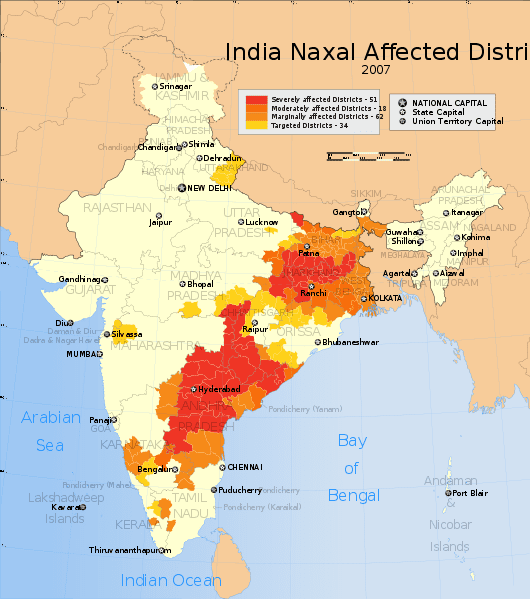 | ||
Zomia is a geographical term coined in 2002 by historian Willem van Schendel of the University of Amsterdam to refer to the huge mass of mainland Southeast Asia that has historically been beyond the control of governments based in the population centers of the lowlands.
Contents
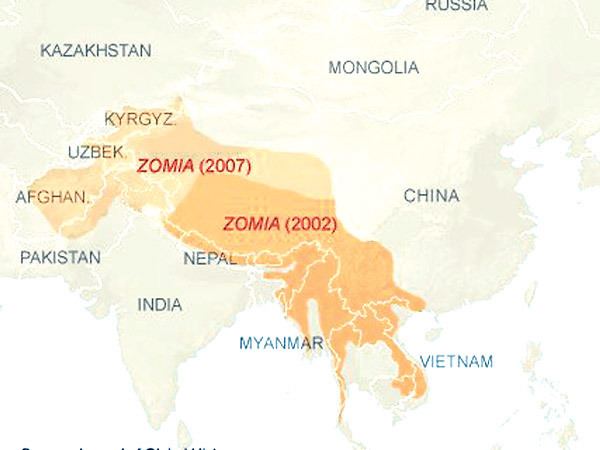
Etymology

The name is from Zomi, a term for highlander common to several related Tibeto-Burman languages spoken in the India-Bangladesh-Burma border area.
Geography
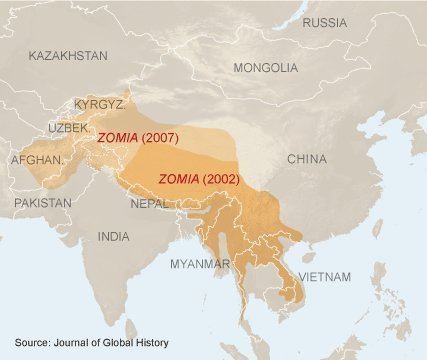
The exact boundaries of Zomia differ among scholars: all would include the highlands of north Indochina (north Vietnam and all Laos), Thailand, the Shan Hills of northern Myanmar, and the mountains of Southwest China; some extend the region as far west as Tibet, Northeast India, Pakistan, and Afghanistan. These areas share a common elevated, rugged terrain, and have been the home of ethnic minorities that have preserved their local cultures by residing far from state control and influence. Other scholars have used the term to discuss the similar ways that Southeast Asian governments have handled minority groups.

Zomia covers more than 2,500,000 square kilometres (970,000 sq mi) over the Southeast Asian Massif and comprises nearly one hundred million marginal people. This large area is inside the fringe of eight states and the entirety of one, stretching across the standard regional designations (South Asia, East Asia, and Southeast Asia). Along with its ecological diversity and its relation to states, it arouses a lot of interest. It stands for an original entity of study, a type of international appellation, and a different way in which to study regions.
James C. Scott
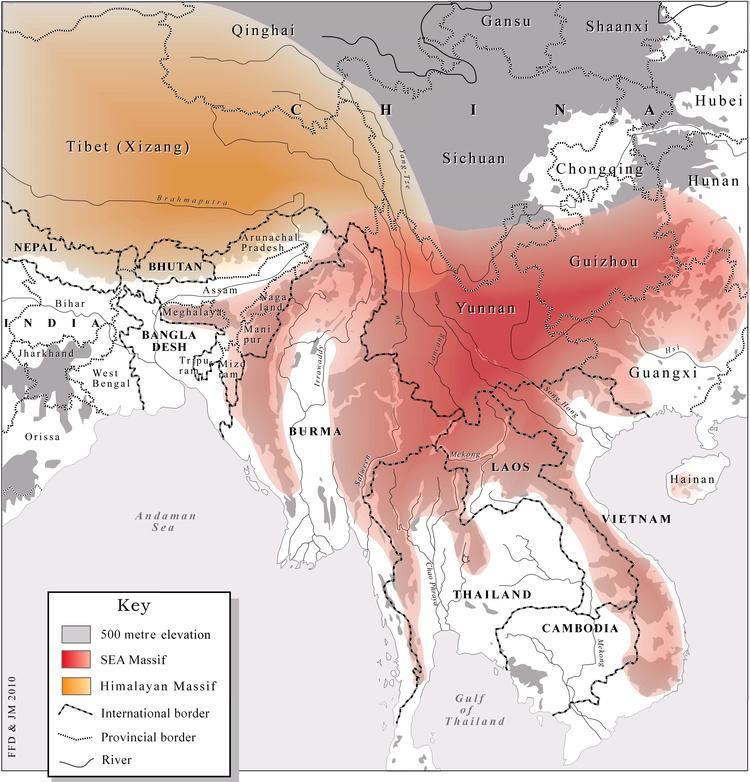
Professor James C. Scott of Yale University used the concept of Zomia in his 2009 book The Art of Not Being Governed: An Anarchist History of Upland Southeast Asia to argue that the continuity of the ethnic cultures living there provides a counter-narrative to the traditional story about modernity: namely, that once people are exposed to the conveniences of modern technology and the modern state, they will assimilate. Rather, the tribes in Zomia are conscious refugees from modernity itself, choosing to live in more primitive, locally based economies. From his preface:
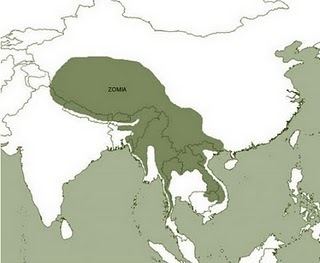
[Hill tribes] seen from the valley kingdoms as 'our living ancestors,' 'what we were like before we discovered wet-rice cultivation, Buddhism, and civilization' [are on the contrary] best understood as runaway, fugitive, maroon communities who have, over the course of two millennia, been fleeing the oppressions of state-making projects in the valleys — slavery, conscription, taxes, corvée labor, epidemics, and warfare.
Scott goes on to add that Zomia is the biggest remaining area of earth whose inhabitants have not been completely absorbed by nation-states, although that time is coming to an end. While Zomia is exceptionally diverse linguistically, the languages spoken in the hills are distinct from those spoken in the plains. Kinship structures, at least formally, also distinguish the hills from the lowlands. Hill societies do produce "a surplus", but they do not use that surplus to support kings and monks. Distinction of status and wealth abound in the hills, as in the valleys. The difference is that in the valleys they tend to be enduring, while in the hills they are both unstable and geographically confined.
Differing perspectives
Jean Michaud explains the many dilemmas that arise from the language used to address the group of people residing in Zomia in his Historical Dictionary of the Peoples of the Southeast Asian Massif. The people of Zomia are often referred to as "national minority groups," and Michaud argues that contention arises with each of these words. In regards to the word "national," Michaud claims that the peoples of the Southeast Asian Massif are in fact transnational, as many groups span over several countries. According to Michaud, "minority" is not the legitimate way to label the group either, since the populations are so vast. Michaud even claims that the word "group" is problematic because of its connotation with community and “social cohesion” that not all groups share.
In 2010, the Journal of Global History published a special issue, "Zomia and Beyond", in this issue, contemporary historians of Southeast Asian history respond to Scott’s arguments. For example, although Southeast Asian expert Victor Lieberman agrees that the highland people crafted their own social worlds in response to the political and natural environments that they encountered, he also finds Scott's documentation to be very weak, especially its lack of Burmese-language sources, saying that not only does this undermine several of Scott's key arguments, but it brings some of his other theories about Zomia into question.
Furthermore, Lieberman argues that Scott is overestimating the importance of manpower as a determinant in military success. While the bulk of Scott’s argument lies on the efforts of lowland states to dominate the highlands, Lieberman shows the importance of maritime commerce as an equally contributing factor.
Lieberman also says that examples not included in Scott's analysis need to be taken into consideration. Scott firmly believes that the culture took shape as a defensive mechanism, as a reaction to surrounding political and social environments. Lieberman, however, argues that the highland peoples of Borneo/Kalimantan had virtually the same cultural characteristics as the Zomians, such as the proliferation of local languages and swidden cultivation, which were all developed without a lowland predatory state.
More recently, Scott's claims have been questioned by Tom Brass. Brass maintains that it is incorrect to characterize upland Southeast Asia as "state-repelling" "zones of refuge/asylum" to which people voluntarily migrate. This is, he argues, an idealization consistent with the "new" populist postmodernism, but not supported by ethnographic evidence. The latter suggests that populations neither choose to migrate to upland areas (but go because they are forced off valley land), nor – once there – are they beyond the reach of the lowland State. Consequently, they are anything but empowered and safe in such contexts.
Edward Stringham and Caleb J. Miles analyzed historical and anthropological evidence from societies in Southeast Asia and concluded that they have avoided states for thousands of years. Stringham further analyzes the institutions used to avoid, repel and prevent would-be states. He further concludes that stateless societies like "Zomia" have successfully repelled states using location, specific production methods, and cultural resistance to states.
In popular culture
The title track of Singapore-based art rock band The Observatory's Oscilla (2014) makes reference to Zomia. Singer and guitarist Leslie Low has stated that the album explores "[l]iving off the grid in some way or another, (offering) criticism of existing paradigms, alternatives, the view from the ground up”. Episode 201 of Crash Course World History, Rethinking Civilization, focuses heavily on Zomia as an example of a region where people have willingly escaped from civilizing societies.
